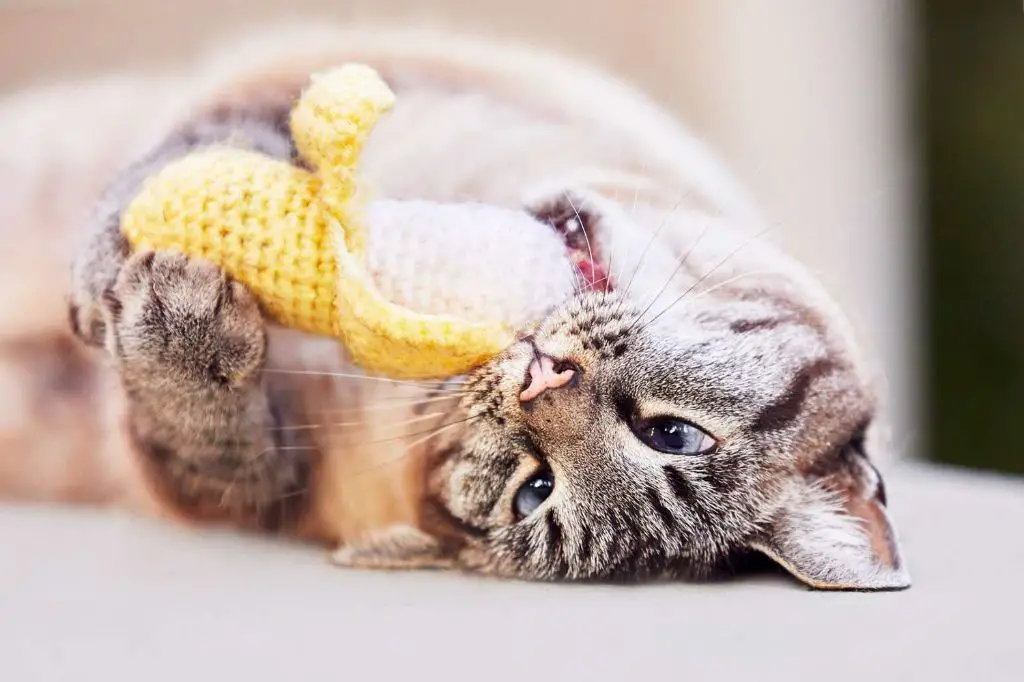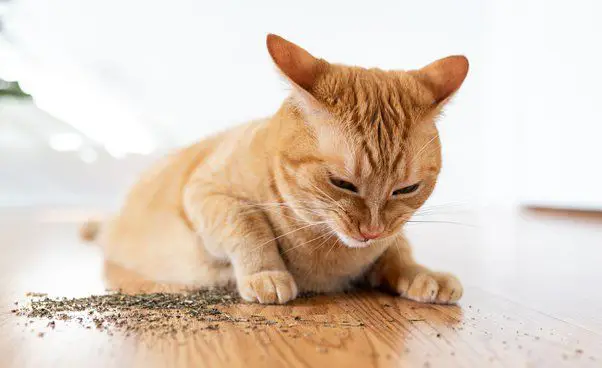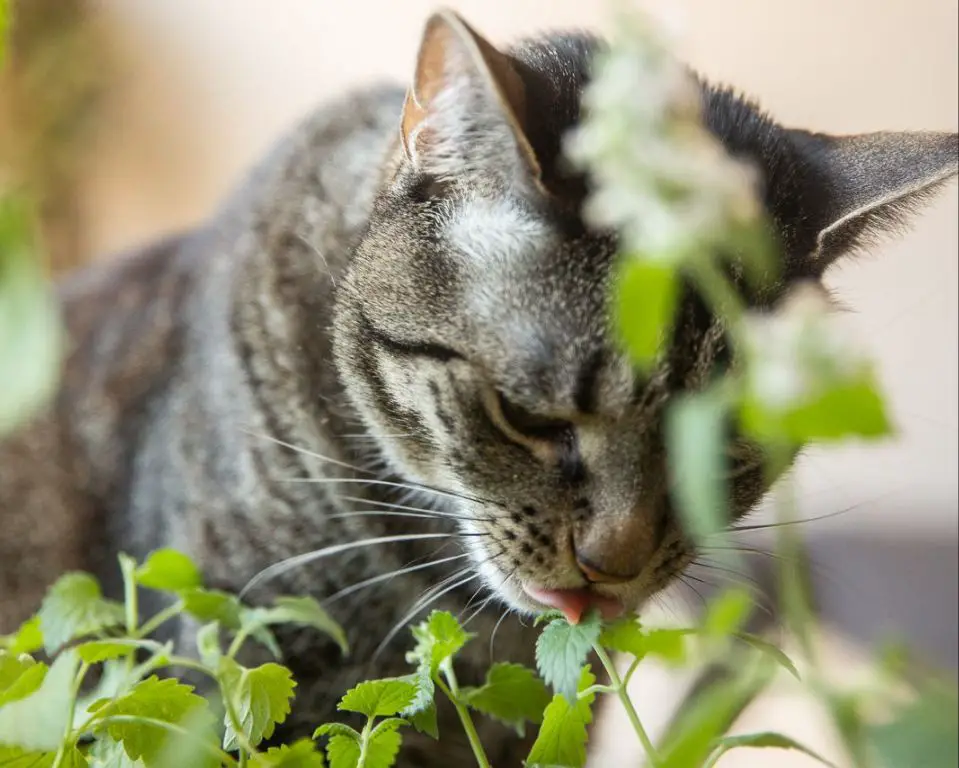Catnip is a plant in the mint family known for its alluring effects on cats. The scientific name for catnip is Nepeta cataria. Catnip contains a chemical called nepetalactone that triggers a response in approximately two-thirds of domestic cats when they smell or ingest it. This substance mimics natural chemicals in a cat’s brain called pheromones, which cause cats to act euphoric when exposed to catnip. Catnip has a minty aroma that draws cats in, even though humans don’t smell the same enticing scent that cats do. In this article, we’ll explore what catnip is, why and how it affects cats, its level of safety for cats and humans, and other uses for this intriguing herb.
Active Ingredient
The main active ingredient in catnip that causes a reaction in cats is called nepetalactone. This is an organic compound that is found in the essential oil of catnip plants. When cats inhale nepetalactone or it is absorbed through their skin, it binds to receptors in their nose and acts as a stimulant.
Specifically, nepetalactone binds to olfactory receptors in a cat’s nose and has an effect on the central nervous system. This causes the stereotypical response seen in cats exposed to catnip, including sniffing, licking, chewing, head shaking, rolling, and rubbing. The exact reason why nepetalactone triggers this reaction is still not fully understood.

Nepetalactone is found in highest concentrations in the leaves and stems of catnip plants. Dried catnip contains about 0.3-0.7% essential oil, of which 30-70% is composed of nepetalactone. This makes catnip more potent when it is dried compared to fresh.
While nepetalactone is the main active compound, researchers have identified other chemicals like nepetalic acid and actinidine that may also contribute to catnip’s effects. But most experts agree that nepetalactone is the primary agent responsible for the hallmark catnip response.
Effects on Cats
The primary active ingredient in catnip that affects cats is called nepetalactone. When cats smell or ingest catnip, the nepetalactone binds to receptors in their brain, causing euphoric effects similar to those produced by some recreational drugs in humans [1]. Many cats experience a temporary sense of blissful euphoria, relaxation, and disinhibition from catnip.
Common behaviors cats display when under the influence of catnip include rolling on the floor, rubbing against things, hyperactivity, vocalizing, drooling, and aggression. The euphoric state makes cats less inhibited and they often engage in silly, goofy, or crazy antics like jumping, pouncing, and tearing around the house at high speeds [2]. It essentially produces a temporary natural “high” for cats that alter their moods and behaviors.
Duration of Effects
A cat’s response to catnip generally sets in very quickly after exposure and lasts for 5-15 minutes. According to the She Knows article on catnip, the effects can last anywhere from 10 minutes to an hour depending on the individual cat. Picture This notes that the effects typically last 10-15 minutes.
Even after the initial response wears off, cats may continue to show residual effects. They may remain in an excited or contented state for up to an hour or more after being exposed to catnip. The active compounds in catnip need to clear the cat’s system before they will have the same sensitivity to another exposure.
Repeated Use

Cats can enjoy catnip multiple times per day, but its effects will be diminished with frequent use. Catnip contains nepetalactone, which binds to receptors in a cat’s nose. This causes the euphoric high that cats experience. However, the receptors eventually become saturated and cannot respond as strongly. As a result, cats need to wait about 2 hours between catnip sessions for the full effects.
Most experts say it’s fine to give a cat catnip a few times per week, but limiting it to once daily is ideal. While catnip is not harmful to cats, overindulging can make them overly hyper or agitated. It’s best to use catnip in moderation as an occasional treat. If a cat ingests or rubs on catnip too frequently, such as multiple times per day every day, the catnip will start to lose its potency and affect them less and less.
Safety
While catnip can have powerful effects on cats, it is actually considered very safe. According to ASPCA Pet Health Insurance, there is no evidence that catnip is harmful to cats or kittens when used appropriately. The active ingredient, nepetalactone, is non-toxic even when ingested. Catnip also does not appear to be addictive.
However, very large amounts of catnip can potentially cause diarrhea or vomiting. Kittens under six months old may experience more exaggerated effects. Some cats may also become more aggressive with very high doses. So moderation is still advised. Overall though, catnip is not considered dangerous and most cats enjoy it with no issues.
Effects on Humans
While catnip can induce euphoric effects in cats, the effects on humans are minimal to mild at best. The active chemical in catnip, called nepetalactone, does not produce an intoxicating high in people (https://www.popsci.com/science/article/2013-04/catnip-effects-humans/). Some reported effects of inhaling or consuming catnip include mild relaxation, dizziness, and anxiety relief. However, these effects are often subtle and not comparable to recreational drug use in humans.

Overall, catnip is not an effective way for humans to get high. The herb produces a much more pronounced high in cats due to differences in their brains’ chemical makeup. Attempting to get high from catnip would require consuming very large quantities, which can cause adverse effects like headaches or nausea. For these reasons, catnip has very limited recreational use potential in humans.
Other Uses of Catnip
Catnip has historically been used by humans as an herbal remedy and insect repellent. According to the Drugs.com article on Catnip (https://www.drugs.com/npc/catnip.html), catnip tea has been used to treat intestinal cramps, indigestion, and as a sedative. The oils in catnip contain chemicals called nepetalactones, which can be used as a mosquito and fly repellent according to the Common Sense Home article (https://commonsensehome.com/catnip/). Catnip essential oil or leaves can be used to repel cockroaches, ants, and deer, making catnip a versatile natural insect repellent. As an herb, catnip has a history of medicinal use for soothing effects.
Availability
Catnip can be purchased from a variety of sources both online and in brick-and-mortar stores. Many pet supply stores will carry catnip, often sold in small bags or containers. Major retailers like Petco, PetSmart, and Pet Supplies Plus frequently stock catnip products. Some grocery stores and mass merchandisers like Walmart may also sell catnip in the pet section. There are also specialty online retailers that focus specifically on cat products, such as Cocktails and Meows that sell catnip toys and organic catnip. For those looking to grow their own catnip, the seeds can be purchased from sites like Seeds Now.

Conclusion
In summary, catnip contains an active ingredient called nepetalactone that mimics feline pheromones and induces a temporary euphoric state when inhaled or ingested by cats. The effects usually last between 5-15 minutes, with diminished efficacy after repeated exposure. Catnip highs are generally safe, with no known serious adverse effects. The plant has mild or no effect on humans, though some report relaxation or insomnia when consumed. Beyond recreational use for cats, catnip also serves as an insect repellant. The plant is sold in pet stores and readily available in the wild in most areas. While not addictive, catnip provides a safe, natural way to enrich a cat’s environment and supply harmless enjoyment.

